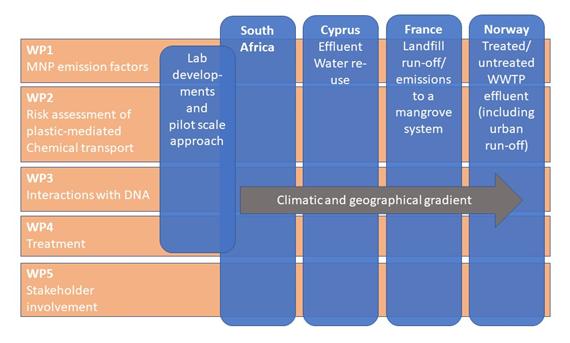NANO-CARRIERS
Micro and NANOplastics as CARRIERS for the spread of chemicals and antibiotic resistance in the aquatic environment
Partners
Partners
Laboratoire Géosciences Rennes (UMR6118 CNRS/Université de Rennes 1)
Nireas - International Water Research Center, University of Cyprus
University of Pau
Durban University of Technology
Abstract
Abstract
An estimated 300 million tons of plastic were produced worldwide in 2015, and this number keeps increasing. This has resulted in a widely acknowledged presence of plastic debris of all sizes in the aquatic environment. The NANO-CARRIERS project will study the threat related to the plastics at the micro and nanometric size emitted through wastewater treatment plants to be trojan horses for chemicals and antibiotic resistance genes into aquatic ecosystems. This project will use an inter-disciplinary approach combining laboratory-based experiments and field measurements to assess (i) emission loads of micro and nanoplastics (MNPs) through treated and untreated wastewater treatment plant effluent, (ii) identify the most relevant chemical additives and chemicals of emerging concern associated with these particles, (iii) the degree of association of DNA to MNPs and the impact of this association on DNA half-life during transfer of to the natural environment with wastewater effluents. Our main approaches will combine laboratory experiments to assess the sorption of DNA to MNPs of different type and sizes, the development of a tool box with methodological developments and harmonisation of protocols for the measurement of MNPs and associated chemicals in wastewater effluents, and field measurements under various scenarios of wastewater effluent treatment, release and re-use. The latter will be based on a strong climatic geographic gradient and under varied socio-economic context since field measurements will be undertaken in South Africa, Cyprus, France and Norway (including the Arctic). This project will include a significant competence building component and will involve researchers at all stages of a scientific career, MSc and PhD students, postdoctoral scientists to (senior) researchers and university professors. This project will deliver key results regarding the possibility of MNPs to act as vector of chemicals and antibiotic resistance genes to the environment.
Project structure:
Project structure:
WP1 will aim to urban wastewater treatment plant-based emission loads of MNPs into aquatic ecosystems under various wastewater treatments and wastewater discharge or reuse options. We will identify and characterise the major types of plastics present at micro and nano-scales
WP2 will aim to identify the most relevant and prevalent chemical additives associated with micro and particularly nano-size plastics as well as chemicals (CEC) adsorbed to plastics from the external environment. In addition we will focus on determining the fate/bioavailability of the chemical additives/CEC and associated risk once released into the environments
WP3 will focus on the evaluation of DNA sorption to MNPs (most common plastics) and possible associated change in DNA half-life in wastewater effluent and receiving waters. We will investigate whether MNPs act as carrier of common DNA in UWTPs effluents and the aquatic environment and evaluate factors influencing sorption
WP4 will aim to assess risk and review treatment and risk management options for various scenarios or case studies proposed in this project
WP5 focuses on stakeholder involvement

Outcomes and expected impact:
Outcomes and expected impact:
NANO-CARRIERS identifies and evaluates a currently unrecognised research priority that needs to be addressed at international level. The risk from the export of MNP-associated chemical additives, CECs and ARGs with treated and untreated urban wastewater effluents has received little attention despite the potential hazard to humans and the environment. As such, our research will provide impacts in the scientific, socio-economic and policy domains. Results from this project are expected to directly influence urban and wastewater management and more precisely identify the possible need for development of mitigation strategies and adoption of additional, new or alternative wastewater treatment options, or whether existing treatment procedures are sufficient. The transnational added value of the NANO-CARRIERS collaboration is related to the differing geographical/climatic, environmental and socio-economic factors that are evidently described in the proposed scenarios of this project set in South Africa, the tropics, the Mediterranean, Northern Europe or the Arctic. Obviously, the risk and resulting need for and type of management and mitigation strategies will differ for the different geographical locations and this is tackled in our project. NANO-CARRIERS will evaluate exposure and risk to human health and the environment and propose mitigating actions and specifically focussed on wastewater treatment and thereby provide society with information, tools and options for the efficient management of MNP in urban wastewater streams. The involvement of stakeholders with direct need for the data and knowledge gathered during this project will ensure and facilitate (i) rapid implementation of mitigation initiatives, (ii) adequate lobbying and raising awareness (of whether a risk is identified or not) and (iii) interaction with governmental institutions with the aim to influence legislation and contribute knowledge toward regulatory measures.